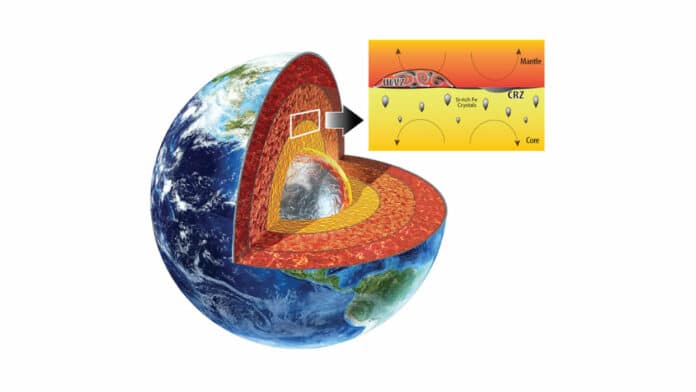Earth’s outer core, made up of a 2,000-km-thick liquid iron alloy layer, affects our surface habitability. An experimental observation of the formation of silicon-rich crystals in an iron-hydrogen alloy liquid at high pressure and high temperature—conditions similar to those of the Earth’s outer core—has just been completed by scientists at Arizona State University.
The silicon- crystals are expected to be lighter than the liquid; therefore, the crystals will rise in liquid iron metal.
Sang-Heon Dan Shim of Arizona State University said, “The silicon-rich alloy crystallization was found during our experiments on snowy winter days in Chicago during the pandemic. Interestingly, crystallization behavior can lead to rising silicon-rich snow in the outer core.”
For the experiment, scientists focused their laboratory observation on predicting that silicon-rich crystals may snow in the outer core, but instead of sinking, they will rise.
At ASU, an iron-silicon alloy is put into a hydrogen-argon gas mixture for this experiment. The samples were then put into a diamond-anvil cell and compressed to the pressures anticipated for the core. To observe crystallization in a diamond-anvil cell using extremely bright X-ray beams, the sample is heated by laser beams to temperatures expected for the core while being held at high pressure at the Advanced Photon Source, a U.S. Department of Energy user facility at DOE’s Argonne National Laboratory.
Shim said, “Creating high enough temperatures for melting iron alloys in hydrogen at high pressure has been very difficult. The reason is that hydrogen can diffuse into diamond anvils and breaks them and fail the experiments.”
“Our team developed a new method where hydrogen is mixed with argon in diamond-anvil cells. Argon does not react with the sample but suppresses hydrogen diffusion into diamond anvils, enabling us to achieve the extreme conditions in laboratory.”
In the transition between the metallic core and the rocky mantle, where numerous enigmatic fine-scale structures have been discovered in seismic imaging studies for decades, this phenomenon can create silicon-rich snow piles.
Suyu Fu of Arizona State University said, “If silicon and hydrogen are the two main light elements in the outermost core with appropriate abundances, such a rising silicon-rich snow can occur.”
In the transition between the metallic core and the rocky mantle, where numerous enigmatic fine-scale structures have been discovered in seismic imaging studies for decades, this phenomenon can create silicon-rich snow piles.
These rising silicon-rich crystal snows may appear as a fine-scale structure with extremely low seismic velocities at the lowermost mantle if the convecting mantle flow can catch some of them. If so, this could explain the ultralow velocity zones observed in the area for decades in seismic studies.
Fu said, “Our study also predicts that the silicon-rich snow starts at the outermost-core region and can develop into greater depths with further secular cooling of Earth.”
Journal Reference:
- Fu, S., Chariton, S., Prakapenka, V.B. et al. Core origin of seismic velocity anomalies at Earth’s core–mantle boundary. Nature (2023).DOI: 10.1038/s41586-023-05713-5
